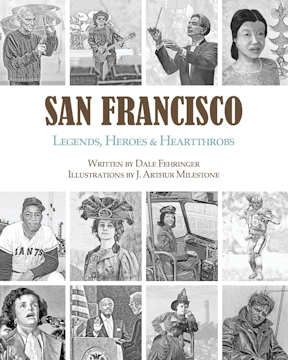April 2021
Need something to read during these days of "shelter-in-place?" Here's a possibility: Our book, titled "San Francisco: Legends, Heroes, and Heartthrobs" is available from San Francisco bookstores (order online). A favorite bookstore is Folio Books in Noe Valley (www.foliosf.com). Or, if you prefer you can order copies from Amazon.com or BarnesandNoble.com.
The book is full of interesting short stories about people who helped make San Francisco -- legends like Emperor Norton and Lillie Coit, artists, musicians, politicians, and sports heroes.
Here is a sample of the type of story you will find. This one is about Janis Joplin, who with Bill Graham, Peter Coyote, Jerry Garcia, Grace Slick, and Carlos Santana makes up the chapter on the Summer of Love. Janis was a favorite of mine ever since I bought her album "Cheap Thrills" in the 1960s. Anybody else have memories of Janis?
Janis Joplin: Do One Thing Well

Eventually, she did find her “thing,” and for a while she was the brightest star in rock-and-roll.
Growing up in Port Arthur, Texas, Joplin was popular through the ninth grade, but was then shunned by her classmates because she was different. That affected her.
Bored and restless, she quit college and moved to San Francisco, where she hung out with Beatniks and sang in clubs. In time, she joined the hippy revolution, experimented with drugs, and had numerous short-term affairs.
Strung out on alcohol and drugs, she returned to Texas, vowing to pursue a “normal” lifestyle. It didn’t last and she moved back to San Francisco. This time she put her whole self into singing, airing her emotions through music.
Her break came in June, 1967, when she performed with Big Brother and the Holding Company at the Monterrey Pop Festival. She rocked the audience and earned good reviews from music critics.
She toured, cut an album (Cheap Thrills), and appeared on television. She was a star, albeit a strange one, with a screeching voice, outlandish behavior, and foul language.
In 1970, she went back to Texas for her 10-year high school reunion and another attempt at acceptance. It was a disaster. She embarrassed her family, her classmates, and herself, and she went back to California discouraged.
She began using drugs again, and on October 4, 1970, in Los Angeles she went to her motel room, shot up heroin, and died. She was 27.
Her life was filled with ups-and-downs, but the person who once described herself as “this chick who was good at this one thing, man” managed to find something she could do well, and she had done it.


